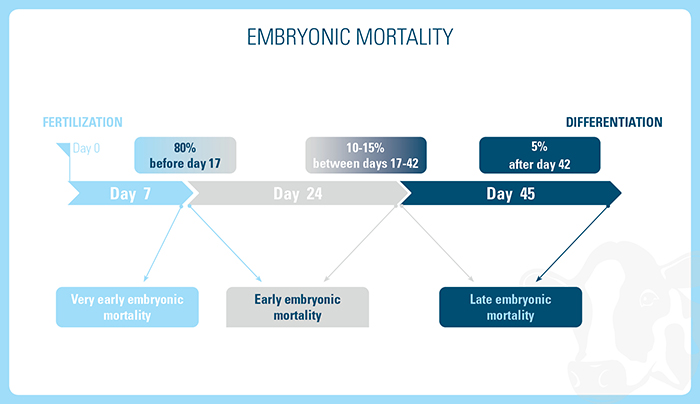

Early Embryonic Death
Embryonic mortality is the loss of the conceptus, which occurs in the first 42-45 days of pregnancy, the period from conception to completion of the differentiation stage.
Frequency of Embryonic Mortality at Different Stages of Cattle Pregnancy1

The possible causes2 of early embryonic deaths include:
- Genetic factors
- Chromosome abnormalities
- Numerical abnormalities
- Aneuploidy
- Polyploidy
- Structural abnormalities
- Best characterized in cattle is the 1/29 Robertsonian translocation, found in various breeds worldwide. Embryonic death occurs within the first or second week of development.
- Numerical abnormalities
- Endocrine factors
- Inadequate progesterone levels
- Impaired luteal function (NEB, infectious causes, heat stress)
- Increased progesterone metabolism in high-producing dairy cows
- Early regression of the corpus luteum (reduced progesterone secretion)
- Inadequate progesterone levels
- Nutritional factors
- Toxins
- Excess crude protein, excess of rumen degradable protein or low levels of rumen fermentable carbohydrate, and the various combinations of these nutrients can cause low conception rates. Excess rumen protein produce excessive levels of ammonia in the rumen, blood and uteri of cows. The excess ammonia needs to be metabolized into urea before excretion, and this costs energy.
- Macromineral deficiencies: calcium, phosphorus
- Vitamin A deficiencies
- Trace minerals deficiencies: iodine, selenium, copper
- Low feed/energy ration or intake: negative energy balance
- Heat stress
- Venereal diseases: trichomoniasis, campylobacteriosis, several viral agents
- Unfavorable uterine environment
- Immunological factors
- Palpation effect
- Improper timing of artificial insemination
- Male effect: transmission of lethal genes and/or virus
- Infectious diseases, i.e., neosporosis
Two methods:
- Ultrasonography: Good tool for early pregnancy diagnosis by the study of ultrasonographic appearance of conceptus
- Immunological methods: Serum concentrations of bPAG-1 (bovine pregnancy associated glycoproteins) for detecting fetal survival
- Administrating GnRH and hCG post insemination
- Improve fertility in cattle herds by preventing early embryonic mortality in cattle

Table 1. Timing of the administration of GnRH and hCG post insemination.
- Supplementing exogenous progesterone/progestogens
- PMSG administration
- Increases progesterone secretion and luteal function without excessive follicular development
- Adequate nutrition to avoid energy deficits and metabolic diseases.
- Early and adequate treatment of the major pathogens adversely affecting reproduction:
- Trueperella pyogenes
- Campylobacter fetus
- Haemophilius somnus
- Leptospirosis
- Neospora
- Bovine viral diarrhea (BVD)
- Infectious bovine rhinotracheitis (IBR)
- Minimizing effects of heat stress on reproduction through nutrition, housing modifications and cooling.
- Ensuring timely ovulation through pharmacological induction at AI or through estrus and ovulation synchronisation systems.
- Pharmacological treatments aiming at support of luteal function and prevention of precocious luteolysis.
- O’Connor, M. 2006. Causes of Embryonic Mortality in Cattle. Penn State College of Agricultural Sciences. https://animalscience.psu.edu.
- Parmar, S., Dhami, A.J., Hadiya, K.K., Parmar, C. 2016. Early Embryonic Death in Bovines: An Overview. Raksha Technical Review. 6. 6-12.

